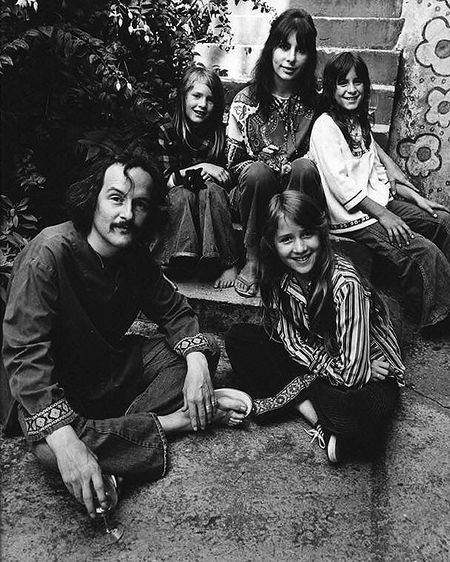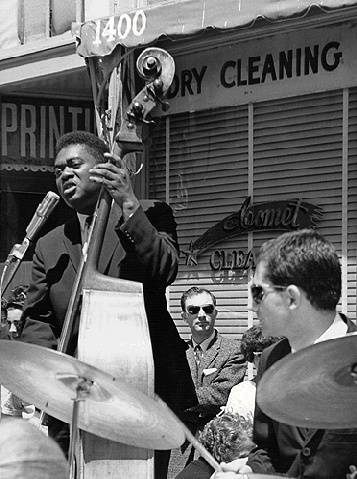David Meltzer on MUSIC AND POETRY
"I was there..."
North Beach outdoor jazz session.
Photo: C.R. Snyder
Excerpted from an interview with David Meltzer (M), conducted by Marina Lazzara (L) and Steven Jones (J).
M: [During the '50s] I was doing a lot of readings at the Jazz Cellar. I was probably the youngest one doing it at the time. All these other people were middle aged (laughter).
L: How old were you?
M: Twenty. Twenty-one. And I was pretty good at it because I felt closer to the music than people like Rexroth or Ferlinghetti, who were basically just reciting poetry against musical background. I was doing more improvisation, trying to treat it as part of the structure of the Jazz performance where you have a band and ensemble, then an arrangement, then people take solos.
L: You're also a musician. Do you think this is why your interpretation was different?
M: Yes, I think so. I also think I identified more with the music. Especially the music of BeBop and post-BeBop, which I listened to a lot as a kid in New York. In fact, I actually belonged to BirdLand and Bop City in the late '40s and early 50's. When I was little I lived with my father in this hotel on 8th Ave. and 48th Street, right near the old Madison Square Garden, where the lobby, depending upon what time of year it was, would be filled with either cowboys or midgets. So I'd just walk down there and listen. And I identified very much with that culture---I suppose you'd call it a Hipster type of culture. Not so much the Beatnik, which was another development.
I brought that sensibility, that relationship to language to the jazz poem. I liked the idea of doing it on the spot. They were always standing there with the mic in front of their face, trying to look cool, but it really worked because they weren't connected to the music particularly. Invariably, they couldn't tell the musicians what to do, so it put this double burden on the musicians.
L: Wasn't there a Bop City here on Fillmore?
M: Yes there was, and I was there too, and that was pretty great. That was an after hours place. Jimbo's.
One of the great things about Beat poetry was the populist aspect of it. It did indeed bring to poetry more of a public presence than it had enjoyed up to that point. It had been strictly formalist in the academy. T.S. Eliot ruled, you know. And New Criticism rocked.
L: I want that on my shirt.
M: New Crit Rocks.
J: Or pebbles or something.
M: It made the performance of poetry a public event that ultimately within a few years period was dethroned by the opening up of Rock concerts.
J: But poetry was still being read before bands, right?
M: That's right. But up to that point the poetry reading was a great social unifier, or cultural unifier in San Francisco. I was in that drift over to the other. I was working for the San Francisco Mime Troupe. Ferlinghetti and myself were intermission poets for the Mime Troupe. We alternated. Graham was managing Mime Troupe at that point. It was during that moment of tenure there that he put together the first concert which was a benefit concert. That pulled in the poetry audience. It was possible to have a poetry reading in a huge auditorium and literally fill it with a couple of thousand people.

David Meltzer and family, 1960s.
Photo: courtesy Christopher Clarke via Facebook
L: Even with their names not recognized.
M: With recognized and unrecognized names. Invariably, the very fact that someone reading for an hour in a downtown auditorium in San Francisco shows you the kind of cultural unifying power these kinds of events had. But then they were replaced by the Rock Concert. Because then you had to put your body into it. The body was activated. The other readings like the soul was activated, they were very emotional, they were politically charged. But it was passive in a sense.
J: Depending on the state of mind, passivity is hard to do.
M: So that's what happened. I remember after doing those kinds of things, [Graham] came back to the Mime Troupe and said, "I don't know, you guys just won't do what I want you to do. I think there's something else out there I want to get involved in."
In any case, in both Southern and Northern California, up to the mid-60s it was just a general umbrella of artists, so there was much more interest between the arts. I'm talking about on all levels of music. Jazz musicians were very interested in poetry. They would go to those kinds of artists, and it would give them a kind of regard.
L: I bet the level of competition wasn't there.
M: Well, there's always competition honing your craft, but there's also regard for accomplishment -- know it when you see it. There was much more cross over. It was always important for painters to have poets as friends. Poets were great in terms of just writing about the painting. Or writing about the music in ways that was equally a work of art. Luckily in North Beach during that Beat period, there was Tom Albright, who wrote the major book on the SF Bay Area art scene. He was working for the Chronicle at that time. To me he was the first example of a peer who was a cultural critic, who was comfortable with culture as a whole.
Kerouac was the only one in that group, by the way, who read poetry with a Jazz flavor and the only one who was very good actually at reading poetry with Jazz as far as I was concerned. He was the only one who really had that panache, that innate awareness of what was going on, because he was a part of that culture. He was again the Hipster and not a Beat. It was like Freud wasn't a Freudian, and Marx wasn't a Marxist. And Kerouac wasn't a Beatnik.

